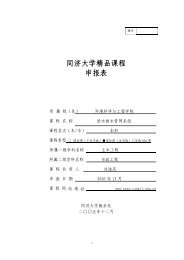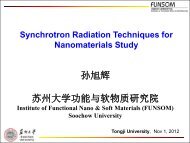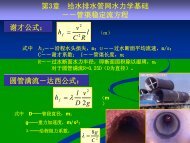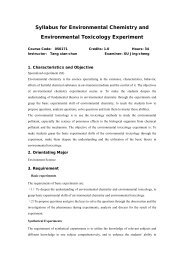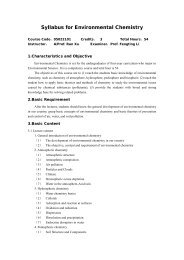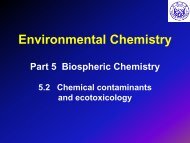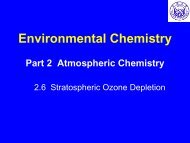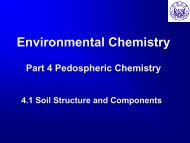Mercury
Mercury
Mercury
Create successful ePaper yourself
Turn your PDF publications into a flip-book with our unique Google optimized e-Paper software.
Environmental Chemistry<br />
Part 5 Typical Pollutants<br />
5.1 Typical Pollutants in the Environment
Typical Pollutants in the<br />
Environment<br />
• Typical inorganic pollutants<br />
Heavy metals: Hg, Cd, Pb, Cr, Zn, Cu, Sn, Ba;<br />
As, etc.<br />
Inorganic salts: cyanide、Nitrogen<br />
salts(ammonium salts 、nitrates、 nitrites)、<br />
sulfides、 fluoride, etc.;<br />
Radioactive species:Natural( 3 H, 235 U, 226 Ra)、<br />
Man-made ( 60 Co, 137 Cs)
• Typical organic pollutants PAHs<br />
Organic halides:halogenated hydrocarbon 、<br />
PCBs、Dioxins<br />
Surface active agent : anionic surfactant 、<br />
cationic surfactant 、 amphoteric surfactant 、<br />
nonionic surfactant
Environmental Chemistry<br />
Part 5 Typical Pollutants<br />
5.2 <strong>Mercury</strong> (Hg)
<strong>Mercury</strong> (Hg)<br />
1. Source and Distribution of <strong>Mercury</strong><br />
in the Environment<br />
• Abundance ratio :63 rd in the Earth’s Crust,80<br />
mg/kg; 40 th in the Ocean,0.15 mg/L<br />
• Forms:nonvalent mercury、univalent mercury、<br />
bivalent mercury<br />
• Distribution:low concentration、broad<br />
distribution;all kinds of rocks;absorption<br />
medium;animals and plants<br />
• Source of pollution:waste water containing<br />
mercury、waste gas and waste residue-from<br />
factories using or producing mercury or mercuric<br />
compounds.
Water: industrial sewage - chlorine alkali 、<br />
plastics、 electronics industry 、<br />
amalgamative ore-refining industry and<br />
fulminating mercury ;<br />
Soil:pesticides containing mercury and sludge<br />
manures;<br />
Air:waste gas containing mercury and<br />
grainnessed mercury-ore-refining、burning<br />
of coal and oil<br />
Air→Soil→Water<br />
Annual produced quantity:>10,000t →<br />
“three wastes”
2. Transport and Transformation of<br />
<strong>Mercury</strong> in the Environment<br />
• Properties of <strong>Mercury</strong><br />
II subgroup element(Cu, Zn), similar to Cu in<br />
chemical and geochemical properties<br />
Specificities:<br />
1) Relatively high oxidation-reduction potential,<br />
presents metallic state;<br />
2) Elementary Substance Hg and its chemical<br />
compounds are highly volatile,p300 chart 6-1<br />
Hg>Hg 2 Cl 2 >HgCl 2 >HgS>HgO; organic<br />
mercury>inorganic mercury; methyl mercury /<br />
phenyl mercury>other organic mercury;
3) Hg: the only metal in the form of liquid<br />
under normal temperature;can<br />
dissolve many metals and form<br />
amalgam ( 汞 齐 ) (Na, K, Au, Ag, Zn, Cu,<br />
Sn, Pb);<br />
4) Covalence( 共 价 性 ): <strong>Mercury</strong><br />
compounds>Znic compounds<br />
The high volatility, mobility and covalence of<br />
mercury and its compounds make easy their<br />
transport and distribution in the environment.
<strong>Mercury</strong> in the air<br />
• come from volatilization of mercury and its compounds<br />
• The volatility and forms of mercury compounds are closely<br />
related to their solubility in water, surface absorption and<br />
atmospheric relative humidity (RH), etc. p300 chart 6-1<br />
• Due to their high volatility, mercury compounds can be<br />
easily released into the air through transpiration( 蒸 腾 作 用 )<br />
of soil and plants.<br />
• <strong>Mercury</strong> in the air are mostly absorbed onto particulate<br />
matters( 颗 粒 物 )<br />
• Gaseous mercury finally enter into soil and marine<br />
sediments.
<strong>Mercury</strong> in the water<br />
• The existing forms of mercury compounds and their<br />
transport and transformation in the environment are<br />
directly related to solubility in water.<br />
1) Hg solubility at 25 o C: 60 mg/L in pure water,25 mg/L in<br />
deoxidized water;<br />
2) Water-soluble salts:HgCl 2 , HgSO 4 , Hg(NO 3 ) 2 , Hg(ClO 3 ) 2 ;<br />
3) Organic mercury:<br />
water insoluble: diethyl mercury( 乙 基 汞 ) (CH 3 CH 2 ) 2 Hg<br />
and ethylmercuric chloride( 氯 化 乙 基 汞 )CH 3 CH 2 HgCl;<br />
slightly soluble:mercury phenylacetate( 乙 酸 苯 基<br />
汞 )PhHgAc;<br />
mercury acetate( 乙 酸 汞 )HgAc 2 has the highest solubility.
4) Hg 2+ can easily form complex compounds ( 络<br />
合 物 ) in the water,ligancy( 配 位 数 ) is<br />
commonly 2 or 4; Hg 2<br />
2+<br />
are much less likely<br />
to form complex compounds than Hg 2+ .
• In oxidizing natural water,<br />
mercury are mostly in the forms of<br />
bivalent mercury (HgCl 2 , Hg(OH) 2 )<br />
and elementary mercury (Hg 0 ) ;<br />
• In the forms of HgCl 3- 、 HgCl 4- in<br />
marine water with high Cl -<br />
concentration;<br />
• In the forms of ethiopsite ( 硫 化 汞 )<br />
in reduced water containing sulfur<br />
(e.g. soil seeper) ;<br />
• In the substrate sludge of water,<br />
inorganic mercury can be<br />
transformed into methyl mercury<br />
by microorganizm.
<strong>Mercury</strong> in the soil<br />
• Over 95% of the mercury entering the soil can be<br />
retented or fixed by soil. Clay minerals and<br />
organic matter in the soil have strong absorption<br />
toward mercury. Thus, mercury accumulates<br />
easily in the surface of soil.<br />
• Amicrobic transformation:2Hg + = Hg 2+ + Hg o<br />
• Microbic :HgS(thiobacillus 硫 杆 菌 )→ Hg 2+ (antimercury<br />
bacteria 抗 汞 菌 )→ Hg 0<br />
• Methylation of mercury (See Bioconversion of<br />
Pollutants)
<strong>Mercury</strong> in the organizm<br />
• Inorganic mercury compounds can easily be discharged<br />
from organizm.<br />
• Combined with macromolecules in the organizm, mercury<br />
can form stable organic complex compounds which are<br />
difficult to be discharged.<br />
e.g. cysteine( 半 胱 氨 酸 ) and albumin( 白 蛋 白 ) can form<br />
highly stable complex compounds with mercury, even<br />
higher is the stability constant K of complex compounds<br />
with methyl mecury, logK=15.7, 22.0
The methylation process of<br />
mercury inside the organizm<br />
1) Main products: aerobic, CH 3 Hg + ; anaerobic, (CH 3 ) 2 Hg<br />
2) CH 3 Hg+: water-soluble, taken by organizm and enter the<br />
food-chain<br />
(CH 3 ) 2 Hg : water-insoluble, volatile, photolytic<br />
3) Formation speed: methyl mercury>dimethyl mercury<br />
4) reciprocal transformation:<br />
CH 3 Hg +<br />
H 2 S<br />
pH4-5<br />
(CH 3 ) 2 Hg<br />
6,000 times<br />
5) peccant materiel( 致 病 性 物 质 )of minamata disease:<br />
methyl mercury, dimethyl mercury, propyl mercury<br />
6) Accumulation: With high fat-solubility, mercury alkyl is<br />
more easier to be concentrated than non-alkyl mercury<br />
and is difficult to degrade.
Methyl mercury<br />
Inorganic mercury in waste water is absorbed by particulate<br />
matter and settle to the bottom of the water body, then<br />
methylated by the microbic transferase.<br />
Methyl mercury can also combine with Cl - or OH - and<br />
generate methyl mercuric chloride ( 氯 化 甲 基 汞 ) or methyl<br />
mercuric hydroxide ( 氢 氧 化 甲 基 汞 )<br />
neutral or acid conditions, methyl mercuric chloride is<br />
dominant<br />
pH=8, [Cl - ]
Dimethyl mercury<br />
Under anaerobic conditions, undersaturated methyl<br />
metals are completely methylated.<br />
p303
• Demethylation of methyl mercury and<br />
reduction of mercury ion<br />
Pseudomonas( 假 单 胞 菌 属 )<br />
Methyl mercury is degraded into methane and<br />
mercury.
Transport and Transformation of<br />
<strong>Mercury</strong> in Environmental Elements<br />
• Due to high volatility, mercury and mercury<br />
compounds entering the soil can be released<br />
into air through the transpiration by soil and<br />
plants and can also enter into surface or<br />
underground water through precipitation.<br />
• In natural water body, mercury is mainly aborbed<br />
by the suspended particulates and finally<br />
become water sediments.<br />
• Environmental factors such as pH and contents<br />
of suspended particulates affect the absorption.
• In the bottom material of a river, mercury is<br />
• related to the transport and transformation of<br />
organic matter, of which suspended mercury is the<br />
main form of mercury transport. Under the effect<br />
of microorganizm, mercury in the bottom soil can<br />
be transformed into methyl mercury, which is<br />
water-soluble and thus released back into water.<br />
• Methyl mercury taken by Aquatic organizm can<br />
accumulate inside the organizm and concentrate<br />
along the food-chain. Fish contaminated by<br />
mercury has an inside concentration of mercury<br />
over 100 times higher than the outside<br />
concentration of mercury in the water.
. Hazards of <strong>Mercury</strong> Pollution<br />
• <strong>Mercury</strong>’s damage to human health depends on the chemical<br />
state, environmental conditions of mercury and the ways of<br />
entering the human bodies.<br />
• <strong>Mercury</strong> vapor is highly diffusible and fat-soluble. It gets<br />
through the respiratory tract and is carried through the whole<br />
body by blood circulation. A large inhalation of mercury vapor<br />
can cause acute toxication such as hepatitis( 肝<br />
炎 ),hepatonephritis( 肾 炎 ),hematuria( 尿 血 ) and uraemia( 尿<br />
毒 ),etc.<br />
• The toxicity effect of organic mercury inside the human body is<br />
related to the organic radicals. Short-chained derivatives of<br />
mercury alkyl are more toxicant than aryl mercury( 芳 基 汞 ) and<br />
methoxyl-ethide mercury compounds( 甲 氧 基 乙 基 汞 化 合 物 ).
Hazards<br />
• Inhibiting a series of SH enzymes, thus damaging<br />
the basic functions and metabolism of cells as well<br />
as the detoxificating function of liver, destroying the<br />
cellular ionic equilibrium by changing the<br />
membrane permeability, preventing the nutrition<br />
from entering the cells and causing the ions to<br />
diffuse from inside the cells, finally bringing death<br />
to the cells.<br />
• Chronic intoxication of mercury includes<br />
neuropathic<br />
symptoms such as headache, faintness, limp<br />
numbness, aches, muscle quivering and ataxia, etc.
. Prevention of <strong>Mercury</strong> pollution<br />
• Improve traditional techniques, adopt substitute<br />
materials and reduce the use of mercury.<br />
• Sealed storage; prevent leaking when using; in case of<br />
dropping, cover with sulfur powder.<br />
• Treatment of waste water containing mercury<br />
Settling method :add sulfide to form HgS, through<br />
settlement and centrifugation.<br />
Ion-exchange method:pump in chlorine gas to transform<br />
elementary mercury into ionic mercury, then add chloride to<br />
change it into anionic complex compounds, and then<br />
remove it using anion exchange resin. Sometimes using<br />
cation exchange resin to treat waste water with a low<br />
concentration of Cl-.
Coagulation method:using alum, iron salts and limes,<br />
etc. as the coagulant<br />
Absorption method:Using active carbon or other<br />
natural macromolecular compounds with strong chelating<br />
power.<br />
Reduction method:ionic mercury is reduced to<br />
elemetary mercury and then filter the waste water.<br />
reducing agent: Al, Zn, SnCl2 etc.<br />
Ion-exchange method/ Coagulation method using iron<br />
salts or aluminum salts/ Absorption method using active<br />
carbon can reduced the concentration of dissolved<br />
mercury in the water to lower than 0.01 mg/L;<br />
The combination of Settling method using sulfide and<br />
Coagulation method can reduce the concentration of<br />
dissolved mercury to 0.02 mg/L;Reduction method is<br />
used when the concentration of mercury in the waste<br />
water is very low.
Environmental Chemistry<br />
Part 5 Typical Pollutants<br />
5.3 Polychlorinated Biphenyls (PCBs)
polychlorinated biphenyls<br />
(PCBs)<br />
• Structure and characteristics of PCBs<br />
209 isomers ( 异 构 体 )<br />
Commonly 3~6 hydrion is substituted by chlorine ion, the<br />
content of Cl is as much as 42%~54%<br />
PCBs with less Cl content is usually in the liquid state. The<br />
more Cl content, the higher the viscosity. As for the external<br />
appearance, it varies from transparent liquid to white<br />
crystallines.
asic characteristics of PCBs<br />
1) Highly stable both chemically and physically; resistant to<br />
heat, acid, alkali, corrosion and oxidation; non-corrosive to<br />
metals.<br />
2) Difficult to dissovle or insoluble, soluble to oil or organic<br />
dissolvant (particularly chloride with high Cl content), also<br />
inter-soluble with plastics.<br />
3) Incombustible except monochloro and dichlor substitutes.<br />
4) Fine adhesive and extensive propeties.<br />
5) Low vapor pressure and volatility (particularly chloride with<br />
high Cl content)<br />
6) High specific inductive capacity (SIC), fine insulativity and<br />
electrochemical properties.
The uses of PCBs<br />
• As the insulative fluid in the transformers and capacitors;<br />
• As the medium in the heat-exchange systems and hydrolic<br />
systems;<br />
• As the additives in the production of lubricant, cutting oil,<br />
pesticide, paint, manifold paper, mastic and encapsulant,<br />
etc;<br />
• As the plasticiser in the production of plastics.<br />
Commercial production of PCBs began in 1930 and<br />
were gradually banned after 1977. PCBs is listed<br />
among the organic pollutants in priority control in<br />
many countries.
Transport and transfomation of<br />
PCBs in the environment<br />
• Since the production of PCBs, it is estimated that over half of<br />
the related products have entered the gabbage dumps. The<br />
combustion of such kinds of gabbage release PCBs to the<br />
atmosphere.<br />
• For the difference in climatic, biological, hydrographical and<br />
geological factors, etc. , the PCBs in the environment<br />
undergo a series of transport and transformation. PCBs are<br />
finally stored up mainly in soil, rivers and the bottom soil<br />
along the water bodies.<br />
• PCBs is water-insoluble and have high octanol-water<br />
partition coefficient, thus are more easily distributed among<br />
settled organic matters and soluble organic matters.
Transport and transfomation of<br />
PCBs in the atmosphere<br />
• PCBs enter into the atmosphere during the process of<br />
using and disposing.<br />
• The depletion of different PCBs depends on their<br />
environmental, phycial and chemical properties.<br />
• There are two main ways of depletion of PCBs in the<br />
atmosphere: direct photodecomposition; reaction with<br />
radicals like OH and NO 3 and also ozone.<br />
The radical OH has the most influence. The half-life of<br />
the reactions with PCBs activated by OH is 2~34 days; with<br />
every one more Cl ion in the PCBs molecule, the reactivity is<br />
reduced in half.
The atmosphere is purified of PCBs through<br />
rainwater flush and dry or wet precipitation, the<br />
process of which transports the pollutants from<br />
atmosphere to water or soil.<br />
Hydrophobic organic matters in the atmosphere<br />
are mainly in gaseous state or absorpt state. PCBs in<br />
the gaseous state and PCBs absorpt by particulate<br />
matters can reach the earth’s surface through dry or<br />
wet precipitation such as gas phase absorption,<br />
gravitational settling and eddy diffusion, etc.
he transport of PCBs in soil<br />
• PCBs continuously enter into soil in different ways.<br />
• Precipitaion of particulate matters is the main resource of<br />
PCBs in soil, while they are also partly from the sludge manure,<br />
leakage from the landfill and the prepartion of pesticides, etc.<br />
It is reported that the content of PCBs in the soil are in<br />
most cases over 10 times higher than that in the air above.<br />
• Except temperature, some other environmental factors such as<br />
clay content and the level of choloridization of PCBs also have<br />
some effect on the volatilization of PCBs in the soil.<br />
Biodegradation and invertible absorption contribute little to<br />
the depletion of PCBs.<br />
• Only the process of volatilization is most likely to cause the<br />
depletion of PCBs, especially those having more Cl content.
The transport of PCBs in water<br />
• PCBs enter into water (rivers, lakes and coastal water<br />
bodies) mainly through the process of atmospheric<br />
precipitation and the discharge of industial sewage,<br />
etc.<br />
• PCBs in water is low in amount is low due to their<br />
high volatility and low solubility in water.<br />
• PCBs are absorpt easily by particulate matters so that<br />
PCBs in water are mostly contained on the surface of<br />
suspended particulate matters and finally settle to the<br />
bottom soil. Thus, PCBs in the substrate sludge is 1 to<br />
2 times higher in amount than that in the water around.
PCBs in the substrate sludge can not easily be<br />
transported or distributed, which makes them stay in the soil<br />
for a long time. Also due to their high fat-solubility, PCBs are<br />
easily accumulated and concentrated in the organism.<br />
Hydrolic systems including substrate sludge and soil, etc.<br />
act as a very important deposition utensil to PCBs and other<br />
hydrophobic organic compounds. With the disappearing of<br />
primary pollution sources, they are likely to become the<br />
secondary pollution sources and release PCBs to the<br />
environment.<br />
The settled PCBs in the environment will continuously<br />
disperse to the oceans and cause the decreasing biotic<br />
population and aggravate the damage to the biological<br />
environment.
The transformation ways of PCBs<br />
in the environment<br />
• PCBs become persistent organic pollutants in the envrinment<br />
(POPs) due to its chemical inertia.<br />
• Main transformation ways of PCBs include photochemical<br />
decomposition and biotransformation.<br />
• Photochemical decomposition :p314 The agitation of ultra<br />
violet can cause the breaking of C-Cl bond and produces aryl<br />
radicals and chlorine radicals.<br />
• Biodegradation:PCBs can be degraded by pseudomonads( 假 单<br />
胞 菌 ), etc. The less Cl content, the more easy the biodegradtion.<br />
• Transformation in internal animals:except accumulation, PCBs<br />
can also undergo transformation through metabolism, the<br />
speed of which is reduced with more chlorine ions in the<br />
molecule.
Hazards of PCBs<br />
• Affect the growth of aquatic plants;<br />
at 0.1-1 mg/L, reduce photosynthesis;<br />
at 10-100 mg/L, inhibit the growth of aquatic plants.<br />
• Most species of fish are senstitive to PCBs during all stages<br />
of their growth. 。<br />
• The absorbtion of PCBs by birds can cause the expansion<br />
and damage of liver and kidney, internal bleeding, collapse<br />
of lien and thickened eggshell, etc.<br />
• PCBs can induce a series of symptons to mammals such as<br />
adenoma and cancer.<br />
• PCBs can cause skin ulcers, acnes, hydatoncus, liver<br />
damage and the increase of leukocytes, etc. Except causing<br />
cancers, PCBs can also be spread to infants and cause<br />
monstrosity.
Degradation of PCBs<br />
• Substrate sludge contains more PCBs with less Cl<br />
content while upper sludge contains more PCBs with<br />
more Cl content, because in the upper strata active soft<br />
soil, PCBs with less Cl content are easily degraded by<br />
microorganizm while PCBs with more Cl content are<br />
relatively stable.<br />
• Water solubility is also a factor. PCBs with higher solubility<br />
are easily biodegraded.<br />
• There is a marked concentration of PCBs when it comes<br />
to biodegradation, which is the lowest required<br />
concentration of PCBs for them to be biodegraded.
Treatment of PCBs<br />
• Mainly include sealing and storage, hightemperature<br />
treatment, chemical treament and<br />
biodegradation, etc.<br />
• Combustion at high temperature is a developed<br />
treatment way for PCBs which will be degraded<br />
completely in 2 seconds at 1200 o C but needs to<br />
prevent the production of dioxins, a significant<br />
canceroge.<br />
• Sealing and storage is a temporary way of<br />
treatment and can’t solve the problem of PCBs<br />
pollution fundamentally.
1) Sealing and storage<br />
• To seal and store the disposed transformer oil<br />
containing PCBs in certain stockhouses or<br />
bury them deeply in concrete pools or store<br />
them in remote caves, waiting for further<br />
treatment.<br />
• However, it would bring risks to the<br />
environment due to the possible leakage of<br />
PCBs from the rusty crust to the surounding<br />
area.
2) High-temperature treatment<br />
• It’s the most common way for treatment of PCBs at<br />
present.<br />
• Simple combustion: By adding a large amount of<br />
fuel and dissolvant, the temperature is raised to up<br />
to 1200 o C-1600 o C in several seconds so that the<br />
disposed transformer oil containing PCBs can<br />
combust and transform into other compounds.<br />
disadvantages: the production of dioxins, benzfuran<br />
and other secondary pollutants.
Fusion medium method( 熔 融 介 质 法 ):using some<br />
inorganic medium such as metals and inorganic<br />
salts, etc. instead of air as the medium for heat<br />
transfer and reaction during the process of<br />
combustion.<br />
This method would not produce dioxins and other<br />
related pollutants and doesn’t have strict<br />
requirements for the samples, but high expense is<br />
needed in the treatment of waste gas and residue.<br />
Plasma method: a technology using plasma as the<br />
heat source, high cost.
3) Chemical removal method<br />
• Under certain conditions, reaction between the<br />
added reagents and PCBs would remove chlorine<br />
from PCBs and produce diphenyl compounds or<br />
other intoxicant or slightly toxicant matters.<br />
• Advantages: complete treatment of waste; simple<br />
equipment that can be easily carried by car after<br />
simple design; applicable to the treatment of<br />
centralized and concentrated PCBs waste, while<br />
also applicable to scattered waste with a low<br />
concentration of PCBs.<br />
• Mainly include:metal reduction method,<br />
hydrogenation method, vulcanization method and<br />
oxidization and chlorinization method, etc.
4) Biodegradation<br />
• A potential method only applicable to waste with<br />
a low concentration of PCBs and slow reaction.<br />
• A combination of primary UV treatment and<br />
secondary microorganizm treamtment is also<br />
practical for the degradation treatment of PCBs.<br />
A thorough and environment-friendly way<br />
for PCBs degradation is badly needed to<br />
solve this tough global problem.
Environmental Chemistry<br />
Part 5 Typical Pollutants<br />
5.4 Surface Active Agent
surface active agent<br />
• Definition: under a low concentration, surface<br />
active agent can fix on to the surfaces of two<br />
phases of a system, through changing the interface<br />
properties, significantly reducing the surface<br />
tension and altering the interface state, thus<br />
causing wetting and dewetting, emulsification and<br />
deemulsification, bubbling and debubbling and<br />
producing solubilizing matter under relatively high<br />
concentration.
Principles<br />
• Surface active agent’s ability to fix on to the interface and<br />
change its properties is due to its amphiphilicity( 两 亲 性 ).<br />
• Molecular structure nonpolar lipophilic group and polar<br />
hydrophilic group;<br />
• Lipophilic group: hydrocarbon chain, polyoxyalkylene chain( 聚<br />
氧 丙 烯 链 ) , fluorocarbon chain( 碳 氟 链 ), silane chain( 硅 烷 链 ),<br />
etc.<br />
• Hydrophilic group: -COOM, -SO 3 M, -CH 2 -CH 2 -O-( 聚 氧 乙 烯 链 )<br />
• Not all molecules with amphiphilic structure are surface active<br />
agents, like sodium formate with a short lipophilic group, thus<br />
it’s not lipophilic enough to become surface active.
Classification and properties<br />
of surface active agent<br />
• Ways of classification: according to the use,<br />
properties and chemical structure;<br />
• Surface active agents are internationally<br />
classified according to the type of the<br />
dissociated surface active ions in water, as the<br />
following:<br />
1. anionic surfactant<br />
2. cationic surfactant<br />
3. amphoteric surfactant<br />
4. nonionic surfactant
1. Anionic surfactant<br />
• The hydrophilic group linking with hydrophobic group is an<br />
anion when anionic surfactant dissovles in water.<br />
• carboxylate:eg. soap RCOONa<br />
• xanthagenate :eg. sodium alkyl benzene sulfonate( 烷 基 苯<br />
磺 酸 钠 )<br />
• sulfuric acid ester salts( 硫 酸 酯 盐 ):eg. sodium lauryl<br />
sulfate( 硫 酸 月 桂 酯 钠 ) C 12 H 25 OSO 3 Na<br />
• organic phosphate salts( 磷 酸 酯 盐 ):eg. sodium alkyl<br />
phosphate( 烷 基 磷 酸 钠 )
2. Cationic surfactant<br />
• The hydrophilic group linking with hydrophobic<br />
group is a cation when cationic surfactant<br />
dissovles in water. ;<br />
• Mainly include the derivatives of orgainic amine( 有<br />
机 胺 ), commonly quarternary ammonium salt( 季 胺<br />
盐 ) like hexadecyl trimethyl<br />
ammonium bromide<br />
( 十 六 烷 基 三 甲 基 溴 化 铵 )<br />
• Aqueous solution of ationic surfactant is highly<br />
disinfectant and thus broadly used as fungicide.
3. Amphoteric surfactant<br />
• It’s the surface active agent composed of both<br />
anionic and cationic ions, the molecular structure of<br />
which is similar to amino acid and the properties of<br />
which in aqueous solution varies with pH.<br />
• Under alkaline condition it presents<br />
anionic properties;<br />
• At isoelectric point it presents nonionic properties;<br />
• Under acid condition it presents cationic properties;<br />
• Can form internal salts inside the molecule;<br />
• Low toxicity, easy biodegradation, fine effects of<br />
rinsing, emusifying, anti-corrosive, disinfectant and<br />
antistatic, etc.;<br />
• High cost, low dosage, potential and promising
4. Nonionic surfactant<br />
• Nonionic surfactant doesn’t disassociate as ions in<br />
aqueous solution but appears in the forms of<br />
molecule or micelle.<br />
• lipophilic group: commonly hydrocarbon chain or<br />
polyoxyalkylene chain( 聚 氧 丙 烯 链 ) ;<br />
• Hydrophilic group: etheriality( 醚 基 ) and hydroxy( 羟<br />
基 )<br />
• Nonionic surfactants are stable in netrality, acid,<br />
slight alkaline conditions and hard water.<br />
• Broadly used in textile, dye printing, metal purging,<br />
food production and pesticide emulsification and<br />
some other industries.
The properties of surface active agent depends<br />
on their chemical structure, related to the<br />
following factors: hydrophilicity, the relative<br />
position of hydrophilic groups, the size of<br />
molecules and the hydrophobic groups<br />
1) hydrophilicity (HLB) is the equilibrium ratio of<br />
the surface active agent’s hydrophilicity and<br />
lipophilicity:<br />
HLB=hydrophilicity of hydrophilic groups<br />
/hyrophobicity of hydrophobic groups<br />
Surface active agent’s HLB value is related to the<br />
HLB value of each of its radicals, the computing<br />
of which is :<br />
HLB=7+Σ(HLB of hydrophilic groups)-Σ(HLB of<br />
hydrophobic groups)
2) the relative position of hydrophilic<br />
groups<br />
• A molecule has stronger wettability when its<br />
hydrophilic groups are located in the middle rather<br />
than at the end of the chain, like the following<br />
molecule, a famous penetrant:<br />
• A molecule has better dirt removing power when its<br />
hydrophilic groups are located at the end rather<br />
than in the middle of the chain, e.g.:<br />
• C 16 H 33 OCOCH 2 CH(SO 3 Na)COOH has better dirt<br />
removing power
3) the size of molecules<br />
• Small-sized surface active agents have better<br />
wettability and permeability;<br />
• Large-sized agents have better ablution ( 洗 涤<br />
作 用 ) and dispersant effect ( 分 散 作 用 ).<br />
e.g. the order of the ablution effectiveness of<br />
alkyl sodium sulfate surface active agent is as<br />
follows:<br />
C 16 H 33 SO 4 Na> C 14 H 29 SO 4 Na> C 12 H 25 SO 4 Na<br />
• Concerning wettability, it appears the<br />
opposite.
4) hydrophobic groups<br />
• The order of lipophilicity of surface acitve<br />
agents with different hydrophobic groups is as<br />
follows:<br />
Fatty alkane 脂 肪 族 烷 烃 >cyclane<br />
环 烷 烃 >fatty alkene 脂 肪 族 烯 烃 >fatty aromatic<br />
hydrocarbon 脂 肪 族 芳 烃 > aromatic hydrocarbon<br />
芳 香 烃 >hydrocarbon with weak hydrophilic<br />
groups 带 弱 亲 水 基 团 的 烃
source and pollution of surface<br />
1. source:<br />
active agent<br />
• 1960s, already largely used in detergent industry<br />
• 1999, global annual use reached 9.3 million t<br />
• 2000, global annual use reached 10.8 million t<br />
• 2005, global annual use reached 12.5 million t<br />
• A large portion of used surface active agent enters<br />
waste water.<br />
• The problem of the degradation of surface active<br />
agent requires attention from environmentalists.
2. hazards<br />
1) Surface active agent is a source material for producing<br />
detergents. As organic matter, synthetic detergents can be<br />
bio-degraded, consuming the dissolved oxygen in the water.<br />
Permernant bubbles appear when the concentration of<br />
surface active agent reaches .<br />
Anionic surfactant produces bubbles in water more<br />
easily than other surfactants.e.g. in 1963,a 0.6 m-thick<br />
sheet of bubbles appeared on the surface of Ohio river<br />
of America, due to the pollution of detergents;<br />
The speed and level of reoxygenation in bubble-covering<br />
river will be largerly reduced. e.g. the pollution of<br />
detergents in Thames river of Britain caused water<br />
deoxidation and people could even smell hydrogen<br />
disulfide along the river.
2) The large amount of phosphates such as trimeric<br />
sodium phosphate ( 三 聚 磷 酸 钠 Na 5 P 3 O 10 )<br />
contained in detergents can cause eutrophy( 富 营<br />
养 化 ) to the water bodies. It’s estimated in Britain<br />
and U.S. and other other countries that 30%~75%<br />
phosphorus in the urban sewage comes from<br />
detergents. Also due to the large amount of<br />
discharged waste water, it would constitute<br />
hazards to aquatic plants and fish.<br />
3) Surface active agents can accelerate the<br />
emulsification and dispersion of petrol, PCBs and<br />
other indissolvable organic matters in water, thus<br />
raising the difficulty of waste water treatment.
4) The sterilization of high-concentrationed cationic<br />
sufactant can make demages to the aquactic<br />
microorganizm communities.<br />
5) The strong dissolving capacity of detergents<br />
toward unctuous matters can damage the<br />
gustatory organ of fish, thus depriving them the<br />
ability to avoid toxicant matters and look for food.<br />
It’s reported that fish can not survive in water<br />
with detergents at a concentration of over<br />
10mg/L.
he degradation of surface active<br />
agent<br />
• It means under the environmental factors,<br />
the molecular structure of surface active<br />
agents is changeg, from environmentharmful<br />
matters to environment-friendly<br />
molecules such as CO 2 , NH 3 and H 2 O.<br />
• Mainly include bio-degradation and<br />
photodecomposition.
1. Bio-degradation of surface<br />
active agent<br />
• priciples:the depletion of surface active agent<br />
entering the water environment depends mainly on<br />
degradation by microorganizm, the principle of which<br />
includes the oxidation of methyl on the methyl-chain<br />
(ω-oxidation), β -oxidation, the oxidation of aromatic<br />
ring and 脱 磺 化 。<br />
1) Methyl oxidation means the oxidation of the methyl at<br />
the end of the hydrophobic groups of surface active<br />
radical and then the respective production of of<br />
formyls ( 醛 基 ) and carboxyls ( 羧 基 ).
2) β -oxidation<br />
• Carboxylic acid in the surface active agent<br />
molecue is oxidized under the effect of A<br />
coenzyme ( 辅 酶 A) and the second carbon<br />
bond breaks.<br />
3) The process of desulfonation<br />
The process of desulfonation happens in the<br />
alkyl chain oxidation of both branched-chain<br />
and linear alkylbezene sulfonates.
4) Oxidation of aromatic<br />
compounds<br />
• The ring-opening process of phenol ( 苯 酚 ) and<br />
salicylic acid ( 水 杨 酸 ) and other compounds includes<br />
the primary production of pyrocatechol ( 邻 苯 二 羟 基 ),<br />
the secondary split of two hydroxyls ( 羟 基 ), and then<br />
the production of dicarboxylic acid ( 二 羧 酸 ) and the<br />
final disappearing.
The effect of the structure of<br />
surface active agent on bio-degradation<br />
1) Cationic surfactant<br />
The bio-degradation of cationic surfactant requires<br />
aerobic conditions. The order of the ability of being biodegraded<br />
of three types of alkylbenzene sulfonates (ABS)<br />
with different structures of hydrophobic groups is as follows:<br />
Linear ABS (LAS)>ABS substituted by a branch-chain at the<br />
end of the group>trimethy ABS<br />
As for those cationic surfactants difficult being degraded, we<br />
can prepare them together with other types of surface active<br />
agents in order to raise its bio-degradation. e.g. trimethyl<br />
dodecyl ammonium chloride ( 三 甲 基 十 二 烷 基 氯 化 铵 )<br />
couldnot be degraded even in 27h while it can be easily<br />
degraded once being mixed with LAS at the radio of 1:1.
2) Anionic surfactant<br />
• Anionic surfactants such as LAS and AES ( 脂 肪 醇 醚 硫<br />
酸 盐 ) constitute a large portion of surface active agents<br />
contained in detergents.<br />
• LAS degrades the most quickly in all the detergents,<br />
which can be hydrolysed by sulfatase to sulfates and<br />
some related fatty alchohol ( 脂 肪 醇 ) and finally further<br />
oxidized to CO2 和 H2O.<br />
• As for LAS, the degradation speed grows with the<br />
farther distance between the sulfo ( 磺 基 ) and the end of<br />
the methyl chian and it degrades the most quickly with<br />
the number of carbon atoms of the methyl between<br />
6~12. The effect of branch-chain is similar to that of<br />
nonionic surfactants.
3) nonionic surfactants<br />
• Easiness for degradation:<br />
linear molecule>normal branch-chain<br />
molecule<br />
molecule with alkyl>molecule with phenyl<br />
Linear carbinol and disubstituted carbinol<br />
oxyethyl compounds can be effectively<br />
degraded by microorganizm in the activated<br />
sludge.
The relationship between molecular<br />
structure and the bio-degradation of<br />
surface active agent<br />
• The biological degradability of surface active agent depends<br />
mainly on the hydrophobic groups. With the linearity ( 线 性 程<br />
度 ) of hydrophobic groups, the degradability of the<br />
quaternary carbon atom at the end of the chain is<br />
significantly reduced with more hydrophobic groups;<br />
• The properties of the hydrophilic groups also have some<br />
influence on the biological degradability. e.g. LPAS( 直 链 伯 烷<br />
基 硫 酸 盐 ) has higher primary bio-degradation speed than<br />
other anions; short-EO-chain polyoxyethylene ( 聚 氧 乙 烯 )<br />
nonionic surfactants are bio-degraded more easily.<br />
• The increase of the distance between between the sulfo ( 磺<br />
基 ) and the end of the hydrophobic groups can raise the<br />
primary bio-degradability of methyl benzene sulfonates<br />
(distance principle).
2. Photodiscomposition of<br />
surface active agent<br />
• Photocatalysic degradation and oxidation are technologies<br />
developed in the recent 30 years.<br />
• Advantages: low cost, mild reaction conditions, no<br />
secondary pollution.<br />
• Reaction speed:<br />
anionic>cationic<br />
aromatic ring part>methyl part<br />
• The degradation speed constant K is only related to the<br />
light source, catalysic activity and the reaction medium<br />
rather than the surface active structure. 。
3 steps for the photocatalysic<br />
degradation reaction ot the surface<br />
active agent on the surface of TiO2:<br />
1) Absorption of surface active agent on the<br />
surface of TiO 2 ;<br />
2) Absorption of UV by TiO 2 and the formation of<br />
electron/hole pair ( 电 子 / 空 穴 对 ) (e - /h + ), and the<br />
further reaction between this pair and the<br />
aromatic ring (Ar) of the surface active agent<br />
and the production of aromatic cations (Ar + );<br />
3) The ring-opening process of Ar + , and successive<br />
oxidation to the fnial production of CO 2.
3. Prospect for the surface<br />
active agent technology<br />
• The fixation of mixed bacteria using the technology of<br />
cellular fixation technoloy ( 固 定 化 细 胞 技 术 ) can enable<br />
several reuse of the reaction system and also reduce the<br />
cost and increase efficiency.<br />
• The foundation of engineering bacteria, produced with<br />
microorganizm in alternate or symbiotic relationship by the<br />
combination of cell fusion technology and gene<br />
engineering technology, can give the engineering bacteria<br />
both the fuction of mixed culture and the advantages of<br />
simple required nutrition, stable metabolism and easy<br />
control, making it the major research direction for the future.
One of the key points in the research of photocatalytic<br />
degradation is to choose the suitable carriers and<br />
develop nanometered TiO 2 , use photoactive matter in<br />
the preparation of photocatalyst agent to produce highefficient<br />
catalyst agent for photocatalyst degradation,<br />
further improve the modification and fixation technology<br />
of catalyst agent and increase the quantum efficiency of<br />
catalyst agent.<br />
The application of optimized combination of biodegradation<br />
and photocatalyst degradation in treating<br />
surface active agent will be more effective.



